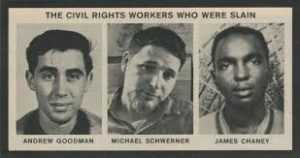James Chaney, Michael Schwerner, Andrew Goodman, and the True Story of Mississippi Burning
[AdSense-A]
When people think about the civil rights movement, two individuals typically come to mind: Martin Luther King, JR., and Rosa Parks. But it took a lot of civil rights activists from many different backgrounds to fight for racial equality then just as it does today. During the summer of 1964, three civil rights activists, all in their early twenties were murdered by members of the Ku Klux Klan for actively working towards bringing racial equality to Mississippi. The three men were James Chaney, Michael Schwerner, and Andrew Goodman. For this article, my focus will be on James Chaney. He was a black man who received the worst treatment when he died.
James Chaney was a civil rights activist from his youth. When he was 15 years old, he was suspended from a Mississippi high school for a week after wearing a NAACP paper badge at school. At the age 19, he was part of the “Freedom Bus Rides”, traveling from Tennessee to Greenville, Mississippi. And a year later at the age of 20, he joined CORE (Congress of Racial Equity), a racially integrated group working towards equality. It was through this group that Chaney began organizing voter education classes for the black community, and it was also how he met Michael Schwerner, a Jewish man in his early twenties from New York. Michael Schwerner along with his wife Rita were sent by CORE to Meridian, Mississippi to run a CORE site that was at the Mt Zion Methodist church.
On June 16, 1964, about two dozen KKK members went to the Mt. Zion Methodist church and attacked the black people present. They returned later and “firebombed” the church. Chaney and Schwerner were not there at the time but were at a training event where they had met Andrew Goodman, another young Jewish man from New York. A week later, the three civil rights activists visited with church members who had been attacked and investigated the church burning. On June 21, 1964, the men were driving on their way from the church site back to Meridian, Mississippi when they were stopped by Sheriff Deputy Cecil Ray Price, who was a Klan member. He arrested the three men and took them to the local jail. James Chaney was charged with speeding while Michael Schwerner and Andrew Goodman were held on suspicion of being part of the church burning. Then, Deputy Price contacted a minister and Klan leader named Edgar Ray Killen, to let him know that he had the civil rights activists in custody.
That night, the three civil rights activists were released from jail after Chaney paid a $20 fine. On their way home, two carloads of KKK members chased the men down, eventually cornering them in a secluded area. Deputy Price, driving his own patrol car, forced the three men into his patrol car and took them to another remote location. Michael Schwerner and Andrew Goodman were both shot and killed by members of the KKK. James Chaney was severely beaten then shot by the KKK members. Their bodies were buried in an earthen dam on farm property owned by another KKK member, and their car was burned in another location. The three activists would be reported missing by a CORE representative and the FBI would also ger involved. The FBI called the investigation “MIBURN” for Mississippi Burning. News of the missing civil rights activists made national news. It took 44 days before the bodies of the three men were found. When the bodies were recovered, the Meridian Star newspaper reported that the body of James Chaney was so badly beaten, that his injuries “could only occur in a high-speed airplane crash!”.
Ten men were charged with committing civil rights violations against the three activists. Deputy Price along with six KKK members were found guilty of these violations and sentenced from anywhere from 3 to 10 years. None of the men were charged with murder.
Dave Dennis, a civil rights activist, delivered the eulogy during James Chaney’s funeral. Photographs showing Chaney’s younger brother, Ben Chaney completely folded over, overwhelmed with grief, were circulated among newspapers. After the funeral, the Chaney family moved from Mississippi to New York due to receiving death threats. The funerals for Michael Schwerner and Andrew Goodman were both held in New York with thousands in attendance.
36 years later, new evidence was obtained through the work of a journalist named Jerry Mitchell, the Mississippi Attorney General’s office, and the FBI. And in 2005, Edgar Ray Killen was charged with the murders of James Chaney, Michael Schwerner, and Andrew Goodman. Killen pleaded “not guilty”. He was found guilty of three counts of manslaughter, but not murder. This happened 41 years to the day of the murders of the civil rights activists. Killen was sentenced to 60 years in prison. He died in prison in 2018 at the age of 92.
The three activists have been remembered in several ways. In 1966, the parents of Andrew Goodman started the Andrew Goodman foundation to honor their son and encourage new leaders of change. In 1967 a four-block long street named “Freedom Place” was established in Manhattan, NY. In 1988 the movie “Mississippi Burning” was released and is loosely based on the 1964 murder investigation. In 1989, Ben Chaney, the younger brother of James Chaney started the James Earl Chaney Foundation to honor the sacrifices of the civil rights activists and to encourage a new generation of civil rights leaders. A memorial was also established for the three activists outside of Mt Zion Methodist church in 1989. And In 2014, the Presidential Medal of Freedom was awarded posthumously to James Chaney, Andrew Goodman, and Michael Schwerner by President Barack Obama.
[si-contact-form form=’2′]


